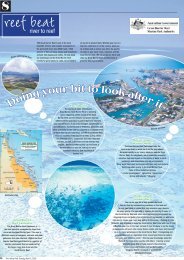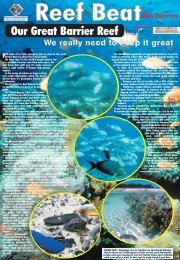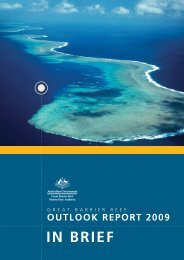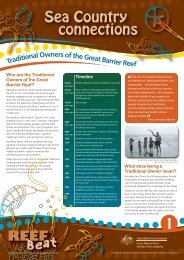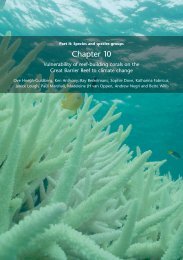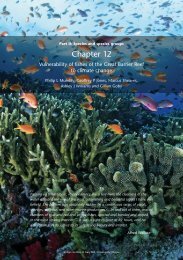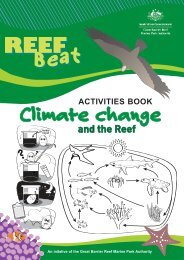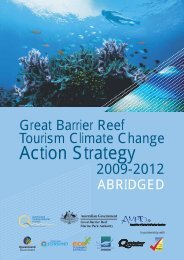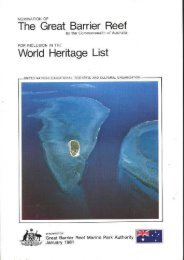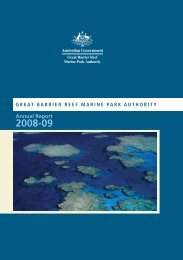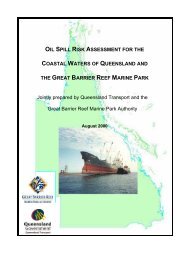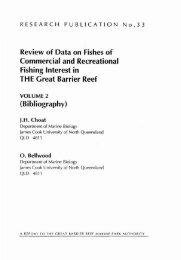Coral Bleaching Response Plan - Great Barrier Reef Marine Park ...
Coral Bleaching Response Plan - Great Barrier Reef Marine Park ...
Coral Bleaching Response Plan - Great Barrier Reef Marine Park ...
Create successful ePaper yourself
Turn your PDF publications into a flip-book with our unique Google optimized e-Paper software.
<strong>Great</strong> <strong>Barrier</strong> <strong>Reef</strong> <strong>Coral</strong> <strong>Bleaching</strong> <strong>Response</strong> <strong>Plan</strong> 2005/2006<br />
<br />
<br />
<br />
<br />
Monitor weather conditions and sea temperatures and compare against thresholds;<br />
Update assessment of conditions and predicted levels of stress to corals;<br />
Solicit and coordinate information about early signs of bleaching through BleachWatch;<br />
Advise Senior Management and Minister of any increase in bleaching risk or bleaching reports.<br />
5.1.2 Responsive Tasks<br />
Confirm bleaching reports (site inspections)<br />
Advise Senior Management, Minister, stakeholder groups and the community of onset of coral<br />
bleaching;<br />
Implement broad-scale synoptic surveys to assess bleaching extent;<br />
Deploy bleaching survey team to measure extent and severity of bleaching;<br />
Monitor ecological impacts of bleaching.<br />
5.2 Definition of Event Triggers for Implementation <strong>Plan</strong><br />
The triggers for monitoring tasks and briefings outlined in the Implementation <strong>Plan</strong> (Tables 2 and 3) are<br />
defined below.<br />
‘High bleaching risk’ is defined as:<br />
• Persistence of strong hotspots (anomaly > 1.5 deg C) for 2 weeks or very strong hotspots<br />
(anomaly > 2 deg C) for 1 week over majority of GBR region;<br />
• Degree heating days index is greater than 21 at multiple sites;<br />
• <strong>Bleaching</strong> thresholds exceeded at inshore and offshore sites; or<br />
• There are anecdotal reports of bleaching from multiple sites.<br />
‘Low bleaching level’ is defined as:<br />
• Reliable reports of low coral bleaching (1-10% of colonies completely white) from multiple sites<br />
from multiple locations spanning at least two GBR <strong>Marine</strong> <strong>Park</strong> sectors; or<br />
• Reliable reports of mild bleaching (10-50%) from a few sites only, scattered throughout the GBR or<br />
concentrated in only one sector.<br />
‘Moderate bleaching level’ is defined as:<br />
• Reliable reports of moderate coral bleaching (10-50% of colonies completely white) from multiple<br />
sites from multiple locations spanning at least two GBR <strong>Marine</strong> <strong>Park</strong> sectors; or<br />
• Reliable reports of severe bleaching (>50%) from a few sites only, scattered throughout the GBR or<br />
concentrated in only one sector.<br />
‘Severe bleaching level’ is defined as:<br />
• Reliable reports of severe to extreme coral bleaching (>50% of colonies completely white) from<br />
multiple sites spanning multiple GBR sectors.<br />
6. References<br />
Wilkinson, C. (2004). Status of <strong>Coral</strong> <strong>Reef</strong>s of the World: 2004 Summary, AIMS.<br />
Climate Change <strong>Response</strong> Programme - GBRMPA 13



